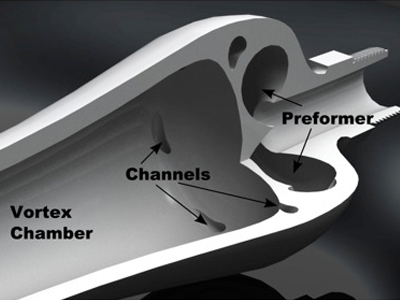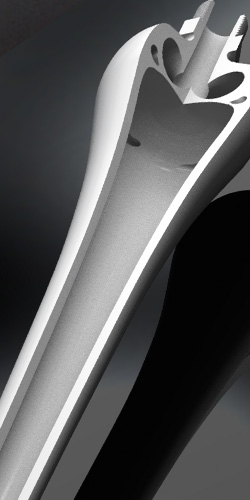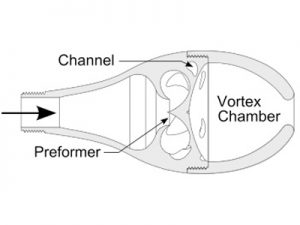VPT – Vortex Process Technology
The Watreco vortex generator is protected by many international patents. It is able to generate a well-defined vortex at a considerably lower pressure and flow than what can be achieved through other techniques.
As illustrated the figure, the vortex generator shapes the fluid flow in three stages:
 Preformer. The inlet of the vortex generator provides a smooth outward direction of the flow through toroidal motion toward a set of well-defined channels.
Preformer. The inlet of the vortex generator provides a smooth outward direction of the flow through toroidal motion toward a set of well-defined channels.- Channels. After the preformer, the fluid is directed through a set of channels, each with vortex-forming geometry. Each channel delivers a jet stream of vortex flow tangentially into a vortex chamber.
- Vortex chamber. In the vortex chamber, the vortices from the channels are wound together, similar to how a rope is spun together from a set of threads. A strong and stable vortex flow is formed inside the vortex chamber, causing a strongly reduced pressure along the vortex axis. Depending on the application, the vortex chamber can have different shapes. A trumpet shape produces a well-defined vortex with a smooth transition to downstream piping. An egg shape with a narrow outlet causes an extensive spread of the fluid which is useful for example in a spraying application or when a large volume of water needs stirring.
The vortex flow gives rise to strong pressure gradients and shear forces. A pressure gradient is the transition between low and high pressure. Shear forces in a flowing medium occur when the flow velocity changes rapidly over a short distance.
The radial pressure gradient in the vortex chamber causes a strong subpressure along the vortex axis. When using water, this subpressure forces gas bubbles (undissolved gas) to move inward toward the vortex axis. If there is enough undissolved gas in the water, a vacuum string along the axis can be clearly visible through a transparent vortex generator. If the pressure gradient is strong enough, cavitation occurs (see below). The strong pressure gradient shifts chemical balances, giving rise to reactions that would not happen under normal flow conditions.
In the vortex generator, shear forces occur not only close to the wall, but also within the fluid itself, for example when the jet streams exiting the channels are wound together. There are also shear forces close to the vacuum string along the vortex chamber axis. The powerful mixing capabilities of the vortex generator are largely due to the strong shear forces which cause a forced but still ordered convection in the flowing medium. The combination of pressure gradients and shear forces causes formation, aggregation or fragmentation of solid matter in the fluid under certain circumstances.
Vortex flow phenomena
Degassing
Macroscopic and microscopic gas bubbles in water will be pulled into the low-pressure zone in the vortex chamber. The low pressure will cause them to expand and gather into large bubbles that can be easily extracted downstream the vortex generator. Dissolved gases are not generally affected by this process. Substances that gather at bubble surfaces may follow the bubbles toward the vortex axis, aggregate and then be separated out.
Mixing
As the low pressure in the vortex chamber goes below the ambient pressure, gases or liquids can be sucked into the vortex chamber. The sucked-in fluid will be efficiently mixed with the spinning medium in the chamber. This process is very powerful in mixing for example water with air or other gases, or water with oil, thus producing stable emulsions.
Cavitation
With a low enough pressure along the vortex axis, cavities (microscopic bubbles) form in the medium. As they move into high pressure zones, they will rapidly implode, producing shock waves and an extreme release of heat within a small volume. This process is called cavitation and may for example induce the formation of lime (calcium carbonate) particles.
Properties of vortex processed water
An examination of the properties of vortexed water was made in 2010 and 2011 by the Polymer Technology Group Eindhoven BV (PTG/e), an independent research and knowledge institute which is a part of the Eindhoven University of Technology (TU/e). Samples were taken from municipal water in Holland, before and after VPT treatment. Water treatment was made with a standard Watreco vortex generator at a water pressure of 3.5 bar.
Viscosity
A decrease in viscosity was observed by PTG/e after VPT treatment. The difference was between 3% and 17%, depending on water quality and temperature. As shown by Albert Einstein in 1905, gas bubble content affects the viscosity of water. As bubbles (undissolved gases) are removed, a decrease in viscosity can therefore be expected.
Heat transfer
VPT treatment changed the melting behavior of ice. The heat capacity was 5% higher for ice and 3% higher for liquid water.
Electrical conductivity
There was an increase by 3% in electrical conductivity after VPT treatment in the PTG/e study. This can be due to either changes in viscosity or a change in the properties of charged particles and/or ions in the water.
Surface tension
Even though viscosity is reduced by VPT treatment, changes in surface tension were not observed by PTG/e.

